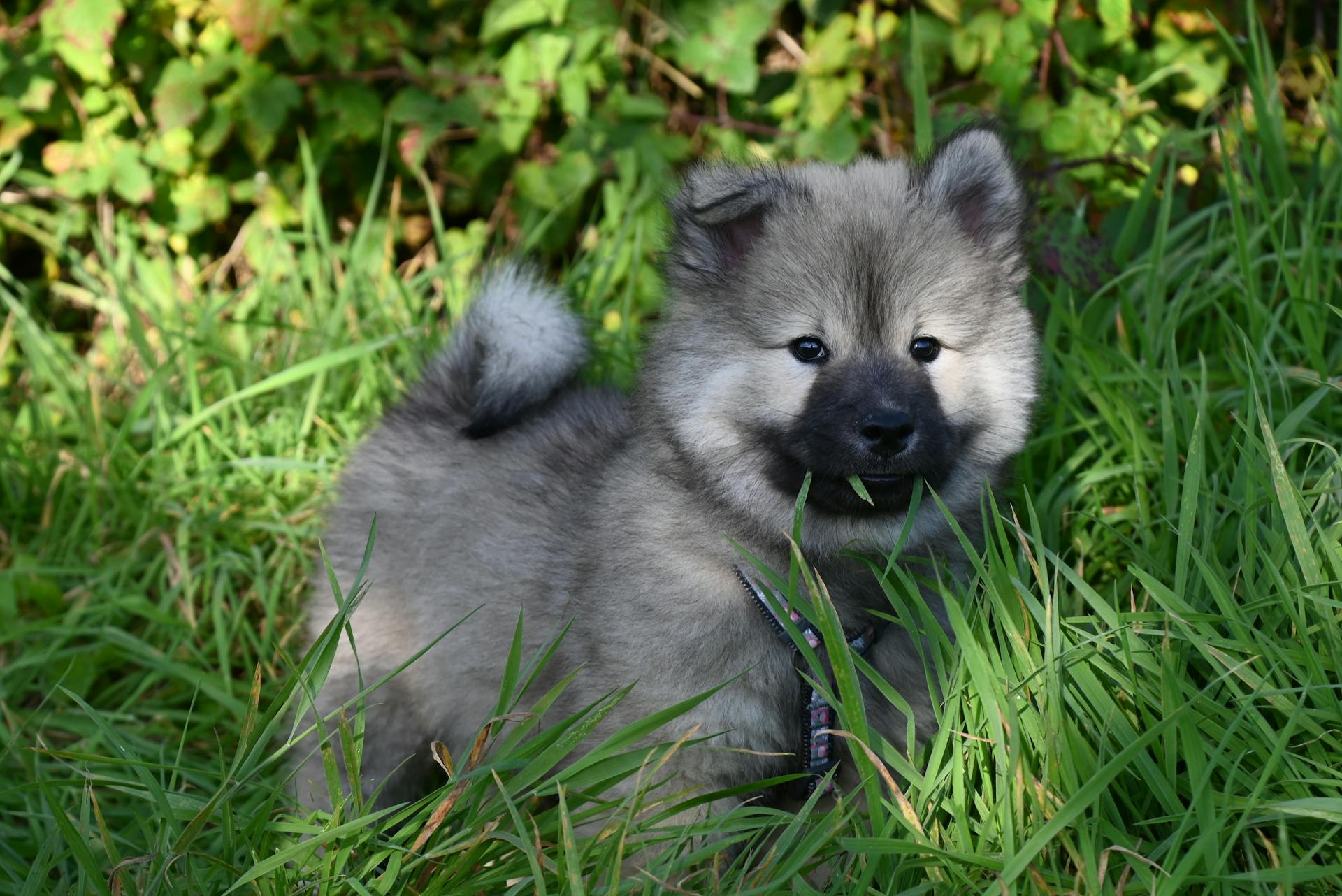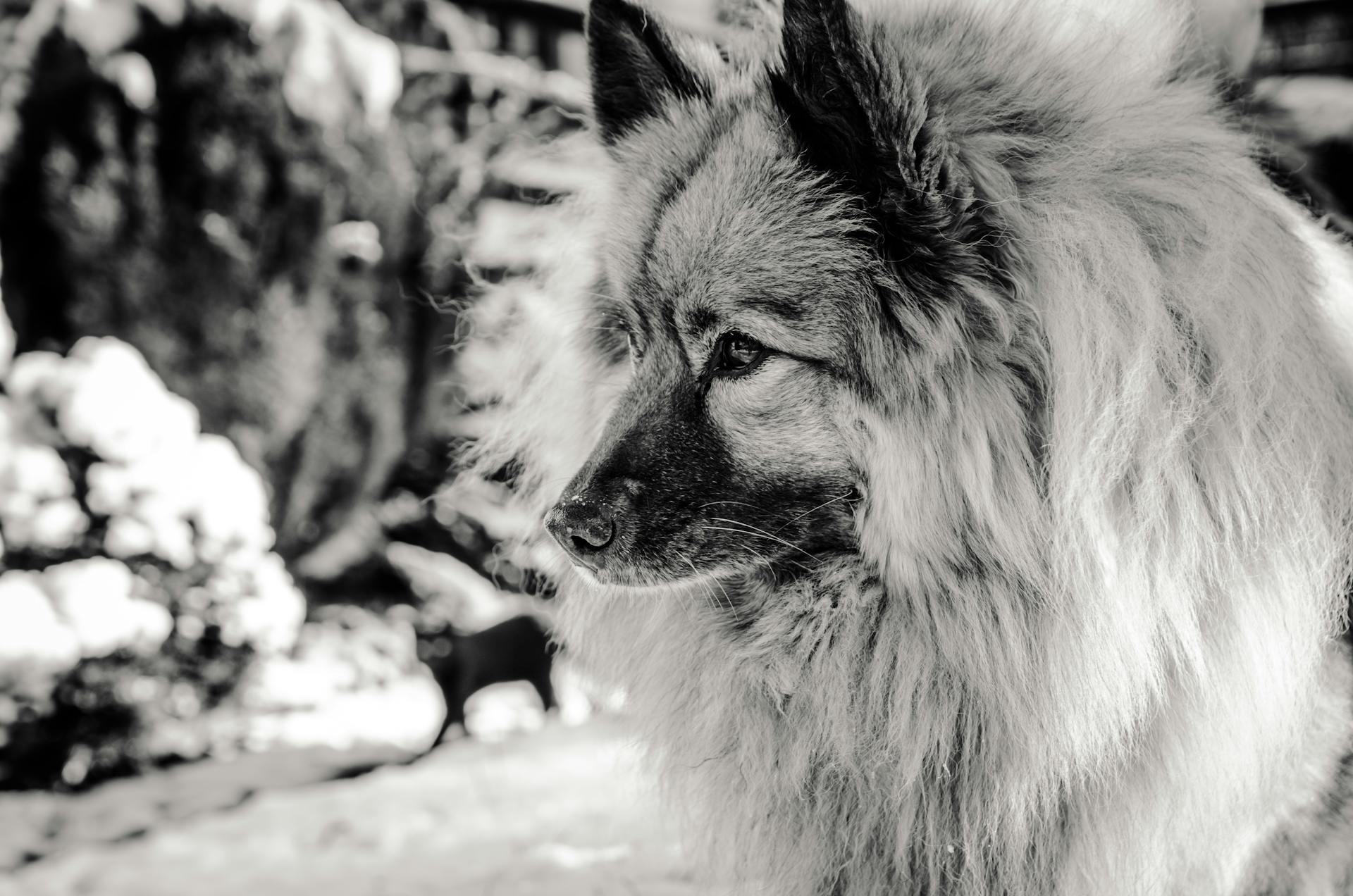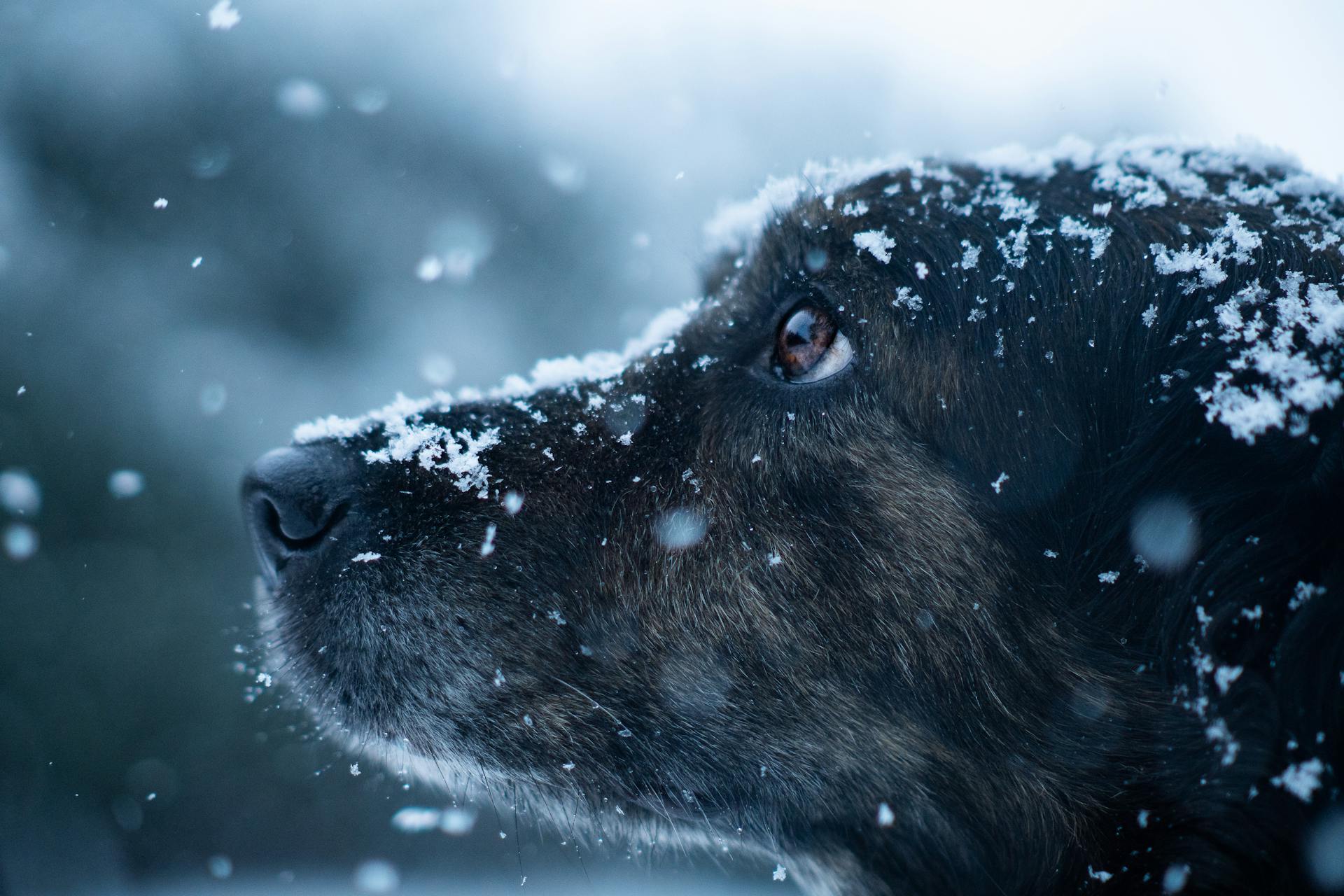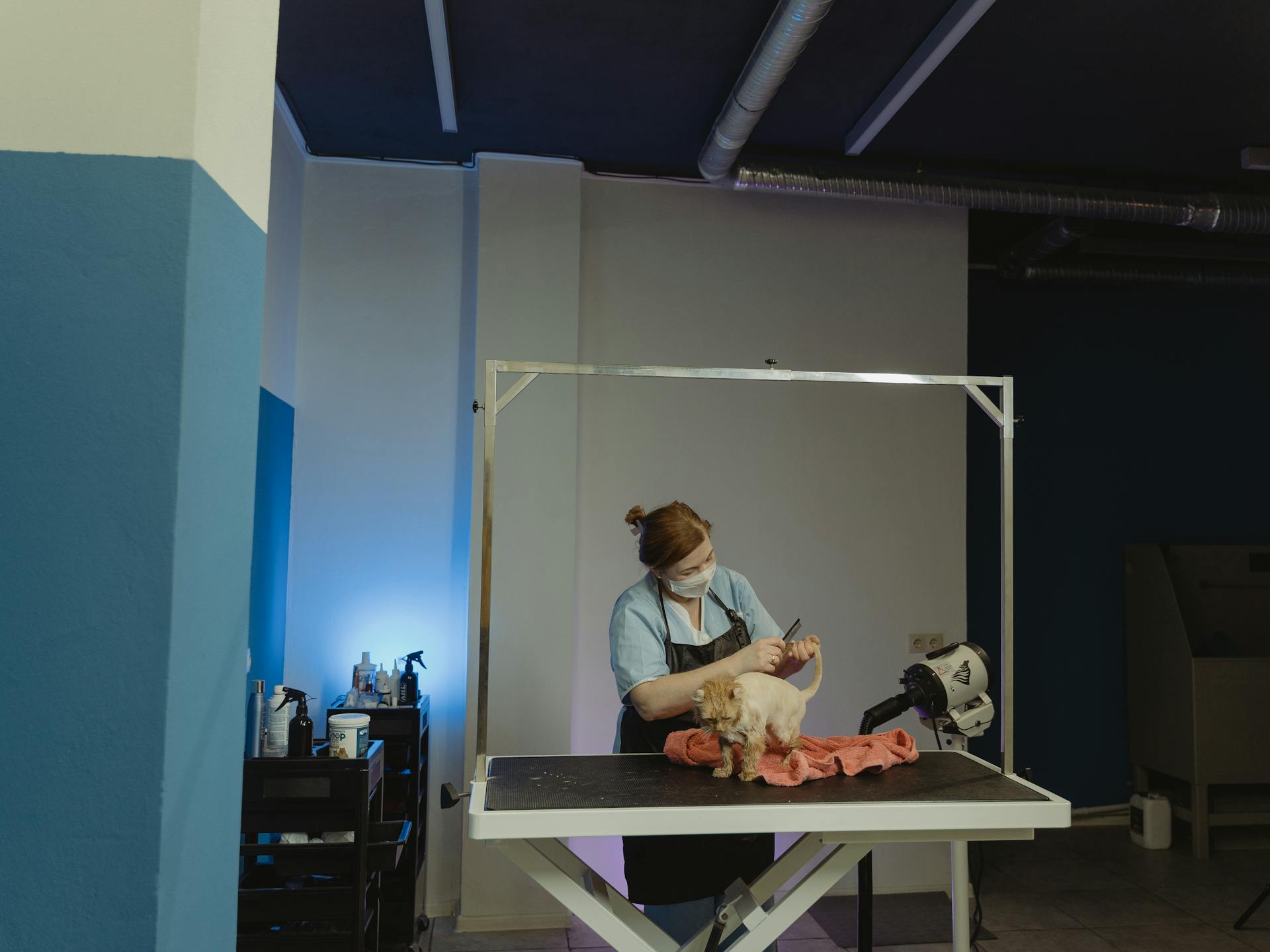
The Keeshond Spitz is a breed of dog that originated in the Netherlands and is known for its distinctive fox-like appearance. They are a medium-sized dog with a thick double coat that requires regular grooming.
Keeshond Spitz dogs are generally good with children and make great family pets.
Physical Characteristics
The Keeshond is a natural, handsome dog with a well-balanced, short-coupled body.
Males stand 18 inches tall and weigh approximately 45 pounds, while females stand 17 inches tall and weigh approximately 35 pounds.
The breed is double-coated, with a long, straight, harsh overcoat that stands out well from the thick, downy undercoat.
The head, including the muzzle, skull, and ears, is covered with a smooth, soft, short hair that is velvety in texture on the ears.
Size
Keeshonds are a medium-sized breed. Males stand 18 inches tall. They weigh approximately 45 pounds. This makes them a great companion for families with children or for people who live in smaller spaces. Females stand 17 inches tall. They weigh approximately 35 pounds.
Characteristics
The Keeshond's physical characteristics are truly one-of-a-kind. Their plush double coat is a standout feature, and it's not just for show - it helps them thrive in various environments.
Their distinctive "spectacles" or markings around their eyes are a key part of their expression, and they must include a delicate dark line slanting from the outer corner of each eye toward the lower corner of each ear.
A well-balanced, short-coupled body is a hallmark of the Keeshond breed, and it's complemented by their fox-like expression, small, pointed ears, and richly plumed tail.
Their hindquarters are thickly coated down to the hocks, forming breed-characteristic "trousers", while their head, ears, and lower legs are covered in thick, short hair.
Here are some key characteristics to keep in mind:
Their friendly and outgoing temperament makes them excellent family pets and companions, and they're known for their intelligence, alertness, and loyalty.
Coat
The Keeshond's coat is one of its most distinctive features. It's a double coat, consisting of a thick, downy undercoat and a longer, straight overcoat that stands out well from the undercoat.
The overcoat must not part down the back, and the head, muzzle, skull, and ears are covered with a smooth, short hair that's velvety in texture on the ears. The neck is covered with a mane that's more profuse in males.
The mane sweeps from under the jaw and covers the front part of the shoulders and chest, as well as the top part of the shoulders. The hair on the legs is smooth and short, except for the feathering on the front legs and the trousers on the hind legs.
The hind legs have profuse feathering down to the hocks but not below. The hair on the tail forms a rich plume.
Brushing is essential to maintain the Keeshond's coat, and it's recommended to brush at least twice a week to prevent matting.
Eyes
The eyes are a distinctive feature of this person's physical characteristics. They are medium in size and almond-shaped, set obliquely on the face.
One thing that stands out about the eyes is their dark brown color. They are not too wide or too close together, giving them a balanced and harmonious look.
The eye rims are a deep black color, which adds contrast to the dark brown of the iris.
Intriguing read: Brown Japanese Spitz Dog
Personality and Temperament
The Keeshond spitz is a loving and loyal companion, bred to be a devoted friend rather than a watchdog. They're highly intelligent and trainable, but can be a bit mischievous at times.
Their outgoing personality shines through when they're excited or happy, often leading to spinning in circles. They love adults and children alike, making them a great addition to any family.
Early socialization is key to raising a well-rounded Keeshond puppy. Enrolling them in a puppy kindergarten class and exposing them to various people, sights, sounds, and experiences will help them develop good social skills.
Here are some key characteristics of the Keeshond spitz personality and temperament:
- Loving and loyal to family members
- Easily trainable
- Low-maintenance and great for small spaces
Their lively and alert nature makes them a joy to be around, and with proper training, they can excel in the obedience ring.
Health and Care
The Keeshond spitz is a relatively low-maintenance breed when it comes to exercise, but they do need daily walks to stay happy and healthy.
Plan on at least one vigorous daily walk, as the Keeshond is not generally suited for long-distance running.
Keeshonds are also sensitive to hot climates, so keep them inside in an air-conditioned house or near fans on hot days.
They'll also enjoy lounging in a small children's wading pool filled with cool water.
Some common health problems that can affect Keeshonds include hip dysplasia, luxating patella, cataracts, primary hyperparathyroidism, diabetes mellitus, and ventricular septal defect.
Here are some common health issues that can affect Keeshonds, along with a brief description:
- Hip dysplasia: Weakness, lameness, or pain in the hips
- Luxating patella: Knee cap moving in and out of place
- Cataracts: Blurry or cloudy vision due to age
- Primary hyperparathyroidism: Overproduction of parathyroid hormone
- Diabetes mellitus: Increased thirst, appetite, and urination
- Ventricular septal defect: Congenital heart defect causing shortness of breath
Health
Keeshonds are generally healthy, but like many purebred dogs, they can be prone to certain genetic health conditions.
Hip dysplasia is a common issue in keeshonds, characterized by weakness, lameness, or pain in the hips due to a malformation in the hip joints.
Luxating patella is another condition often seen in small breeds like keeshonds, where the knee cap moves in and out of place, resulting in severe pain.

Cataracts are a common age-related issue in dogs, causing blurry or cloudy vision, but in severe cases, surgery can help.
Keeshonds can genetically inherit primary hyperparathyroidism, which causes an overproduction of parathyroid hormone.
Diabetes mellitus is another condition that can occur in keeshonds, where the body doesn't secrete or use insulin properly, leading to increased thirst, appetite, and urination, along with weight loss.
Ventricular septal defect is a congenital heart defect that can cause symptoms like shortness of breath, and a vet might notice a heart murmur.
Some common health problems in keeshonds include:
- Hip dysplasia
- Luxating patella
- Cataracts
- Primary hyperparathyroidism
- Diabetes mellitus
- Ventricular septal defect
Care
The Keeshond is a happy-go-lucky breed that thrives in a household with plenty of family interaction. They were originally bred as companions, so it's essential to spend quality time with them in the house on a daily basis.
To prevent boredom and excessive barking, make sure to keep your Keeshond indoors with you, especially on hot days when they're not fond of the heat. They'll appreciate the cool weather and can even enjoy lounging in a small children's wading pool filled with cool water.

One vigorous daily walk is sufficient for this breed, as they don't require a lot of exercise. However, it's still important for their health and yours to get some physical activity together.
Their thick coat requires minimal grooming to stay soft and tangle-free, which is a bonus for busy owners.
Grooming
The keeshond's grooming needs are relatively low-maintenance, but they do require regular attention to prevent matting and tangles.
Brush your keeshond at least two times per week to keep their coat looking its best and prevent matting. This breed sheds heavily twice a year, so be prepared for some extra grooming during these periods.
These shedding periods can last up to three weeks, so it's essential to be consistent with your grooming routine. You can also trim the fur on the hocks and feet to keep them looking neat.
Don't let the heat get to you - keeshonds aren't tolerant of warm temperatures, but shaving them is not the solution. Their thick coat actually acts as insulation, keeping them cool and protected from sunburn.
Readers also liked: Keeshond Grooming
Brush your keeshond's teeth at least twice a week to prevent dental disease, and daily brushing is even better. Don't forget to clean debris from their ears with a soft cotton pad each week.
If your keeshond's ears become red, swollen, or have an unusual smell, it's time to contact your vet to determine if it's an infection. Regular grooming and ear checks can help prevent these issues.
Diet and Nutrition
Feeding your Keeshond the right amount of food is crucial for their health and happiness. A good rule of thumb is to feed them 1 to 2 cups of high-quality dog food divided into two meals each day.
Their individual needs depend on their size, age, build, metabolism, and activity level. A highly active Keeshond will need more food than a couch potato.
You should be able to see a waist when looking at your Keeshond from the side. If you can't, they might need less food and more exercise.
The quality of dog food you buy matters, as better food will go further in nourishing your Keeshond. You can also follow the recommended portions by weight on the dog food packaging.
If you're unsure how much to feed your Keeshond, your veterinarian can help you develop a healthy meal plan.
Ownership and Responsibility
Before bringing a Keeshond Spitz into your family, it's essential to consider the responsibilities involved in dog ownership.
Choosing the right breed is crucial, and Keeshond Spitz are a great option for active families who want a loyal companion.
To ensure you're getting a healthy puppy, finding a responsible breeder is vital. Look for breeders who prioritize the health and well-being of their dogs.
Here are some key things to consider when finding a responsible breeder:
- Research the breeder's reputation and ask for references
- Ensure the breeder is transparent about health clearances and genetic testing
- Ask about the breeder's experience with the Keeshond Spitz breed
Getting started in dog sports can also help you bond with your Keeshond Spitz and provide exercise and mental stimulation for the dog.
Prospective Owners

If you're considering getting a dog, the first step is to Choose Your Breed. This is a crucial decision, as different breeds have unique characteristics and needs. It's essential to research and find a breed that fits your lifestyle and living situation.
You might be wondering Why Get a Dog?. The answer is simple: dogs bring joy, companionship, and a sense of responsibility into our lives. They also encourage us to be more active and social.
Finding a Responsible Breeder is vital to ensuring you get a healthy puppy. Look for breeders who prioritize the welfare of their dogs and provide proper care and socialization.
Getting started in dog sports can be a fun and rewarding experience for both you and your dog. Getting Started in Dog Sports can help you discover new activities and strengthen your bond with your pet.
All puppies are adorable, but it's essential to understand the needs of All About Puppies. This includes proper training, socialization, and veterinary care to ensure they grow into happy and healthy adult dogs.
For another approach, see: Keeshond Pups
Adopt/Buy
If you're considering bringing a Keeshond into your life, you'll want to explore your options carefully. Keeshond puppies typically cost between $1,500 and $2,000, and prices may be higher depending on availability and pedigree.
You might be surprised to find that local shelters may not have many Keeshonds available, but breed-specific rescues can be a great resource. Many similar breeds in need of forever homes may be more readily available in your region, and adopting a rescue can be incredibly rewarding.
If you do decide to purchase a Keeshond from a breeder, it's crucial to do your research and find one that is ethical, reputable, and moral. Responsible breeders should provide medical history and allow prospective adopters to meet the litter's parents.
Here are some resources to help you find a reputable breeder or rescue organization:
- Keeshond Club of America Breeder Listings
- Keeshond Club of America Rescue Organizations
- AKC Keeshond Breeders
Cons of
As a responsible pet owner, it's essential to consider the potential downsides of owning a Keeshond. Intense shedding twice per year can be overwhelming for some owners, leaving a trail of hair everywhere.

You'll need to commit to regular grooming sessions to keep your Keeshond's coat under control. This can be time-consuming and may require additional expenses for grooming tools and services.
Keeshonds are known to bark loudly and often, which can be a challenge for owners who live in apartments or have noise restrictions. This excessive barking can be a sign of boredom or anxiety, so it's crucial to provide your Keeshond with plenty of exercise and mental stimulation.
If left alone for extended periods, Keeshonds can become destructive, chewing on furniture, shoes, or other household items. This destructive behavior is often a result of boredom or loneliness, so it's vital to provide your Keeshond with plenty of attention and activities to keep them engaged.
Here are some common cons of owning a Keeshond:
- Intense shedding twice per year
- Tendency to bark loudly and often
- Can be destructive when lonely or bored
Frequently Asked Questions
Are keeshonds a rare breed?
Yes, the keeshond is a rare breed. Its unique characteristics and charming personality make it a hidden gem worth learning more about.
Is a Keeshond a good family dog?
Yes, Keeshonds are known for their gentle and loving temperaments, making them a great fit for families. They're a medium-sized breed that's easy to love and care for.
Are keeshonds high maintenance?
Keeshonds have a low-maintenance coat that requires daily brushing to prevent matting, making them a great choice for busy owners. With regular grooming, their beautiful coat is easy to manage.
Why do keeshonds bark so much?
Keeshonds bark excessively due to separation anxiety and a strong need for companionship. If left alone for too long, they may express their unhappiness through destructive chewing and barking.
Featured Images: pexels.com
